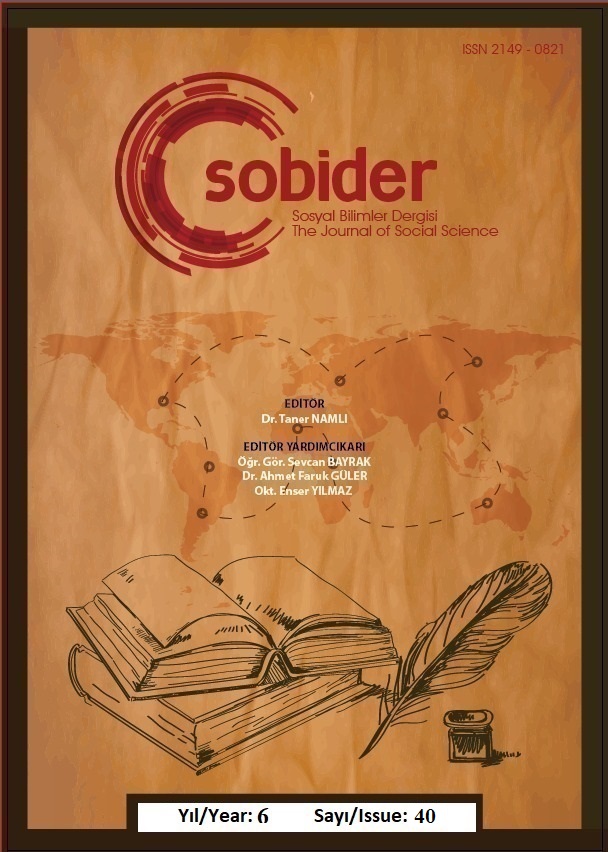Author :
Abstract
II. Abdülhamid Osmanlı Devleti’nin son dönemlerinde yapılan pek çok yenilikte katkısı olan bir padişahtır. Ancak o, klasik saltanat ve hilafet söylemlerinin ötesinde muktedir bir devlet adamı hatta kültür adamı olarak ta ele alınmayı hak etmektedir. Yaşadığı dönemin modern gelişmelerini yakından takip eden, eğitim, bilim, teknoloji ve sanat alanlarında her türlü yeniliğin anında Osmanlı coğrafyasına da getirilmesini teşvik eder. Sinema, tiyatro, müzik ve güzel sanatlarla bizzat ilgilenir. Küçük yaştan beri aldığı özel eğitimlerin de katkısı ile estetik duyarlılığı çok ileridir. Kendisi bizzat müzik ve resim ile ilgilenmiş ve ahşap sanatlarında nadide eserler üretmiştir. Pek çok alanda modern okullar kurdurduğu gibi güzel sanatlar alanında da günümüze kadar önemini ve değerini koruyan bir sanat akademisi kurdurmuştur. Bütün literatürlerde Türkiye’nin ilk güzel sanatlar eğitim kurumu olan Sanay-i Nefise Mektebi’nin Osman Hamdi Bey tarafından kurulduğu kaydedilir. Ancak okulun kurulmasında II. Abdülhamid’in rolünden hiç bahsedilmez. Oysa Sadrazam İbrahim Edhem Bey’in oğlu Osman Hamdi Bey’i kurulan ilk Arkeoloji Müzesinin başına getiren ve güzel sanatlar akademisinin kurulması için teşvik eden yine bizzat sultanın kendisidir. Gerek Batı dünyası gerekse muhalifleri Sultan II. Abdülhamid hakkında olumsuz imajlar üretir. Osmanlı Devleti’nin pek çok kurumunu devralan yeni Türkiye, ne yazık ki mirasının kökleriyle yeterince bağlantı kuramaz. Ancak 21.yüzyılın postmodern yaklaşımları ile yeni kuşaklar, ideolojik bakış açılarından uzak arayışlarla bilimsel anlamda Osmanlı Devleti’nin kurumsal yapısını ve modernizm çabalarını da ele almaktadırlar. Bu çalışmanın amacı II. Abdülhamid’in Sanayi-i Nefise Mektebi’nin kurulmasındaki rolünü ve katkısını vurgulamaktır. Bu açıdan yakın tarihimizin objektif olarak ele alınması ve Türkiye’nin modern kurumlarının temellerinin akademik olarak incelenmesi önem arz etmektedir.
Keywords
Abstract
I. Abdulhamid is a sultan who contributed to many innovations made in the last period of the Ottoman Empire. However, he deserves to be considered as a able statesman and even a man of culture beyond classical discourses of reign and caliphate. It closely follows the modern developments of its era and encourages all kinds of innovations in education, science, technology and art to be brought to the Ottoman geography. He is personally interested in cinema, theater, music and fine arts. Aesthetic sensitivity is very advanced with the contribution of special trainings since the young age. He was personally interested in music and painting and produced rare works in the wooden arts. In addition to establishing modern schools in many fields, it has established an art academy that maintains its importance and value in the field of fine arts. In all literature, first Academy of Fine Arts in Turkey, which Sanay-i Nefise Mektebi was founded by Osman Hamdi Bey. However, The role of II.Abdulhamid is never mentioned. However, it was the sultan himself who appointed Osman Hamdi Bey, the son of the Grand Vizier İbrahim Edhem, to the beginning of the first Archaeological Museum and encouraged the establishment of the Academy of Fine Arts. Both the Western world and its opponents produce negative images about II.Abdulhamid. Many organizations who took over the new Ottoman Empire, Turkey is unfortunately heritage of their roots severed the connection. However, with the postmodern approaches of the 21st century, the new generations also deal with the institutional structure of the Ottoman Empire in a scientific sense and the efforts of modernism in search of ideological perspectives. The aim of this study emphasize the role and contribution of Abdülhamid Khan in the establishment of the Sanay-i Nefise Mektebi. To be addressed in this respect and the basic objective of our recent history of modern Turkey is important to examine the academic institution.
Keywords
- Armağan, M. (2006). Abdülhamid’in Kurtlarla Dansı. Ufuk Yayınları, İstanbul.
- Arseven, C. E. (1983). “Akademi”, Sanat Ansiklopedisi, C.1. S.28. 5.Baskı, Mili Eğitim Basımevi. Ankara.
- Arslan, A. (2013). “Sultan Abdülhamit Döneminde Üniversite Eğitimi”, Vefatının 95.Yılında Abdülhamid Han Sempozyumu, Editör. Nevzat Özkaya, Darülaceze Yayınları, İstanbul.
- Aydın, D. U. (2013). “Sanayi-İ Nefise Mektebi’nin Türk Heykel Sanatındaki Yeri ve İlk Heykeltraşlar”, Yayınlanmamış Doktora Tezi, Ege Üniversitesi, Sosyal Bilimler Enstitüsü, İzmir.
- Cezar, M. (1971). Sanatta Batı’ya Açılış ve Osman Hamdi, 1.baskı, Türkiye İş Bankası Yayını, İstanbul.
- Eldem, E. (2010). Osman Hamdi Bey Sözlüğü, Kültür ve Turizm Bakanlığı Yayını, Ankara.
- Küçük, C. (1988). “Abdülhamid II” İslam Ansiklopedisi, c.1, s.216-224, TDV Yayınları,
- Paşa T. (1999). Tahsin Paşanın Yıldız Hatıratı, Boğaziçi Yayınevi, İstanbul.
- Rona, Z. (1997). “Akademi”, Eczacıbaşı Sanat Ansiklopedisi, Yem Yayınıevi, İstanbul.
- Tansuğ, S (2008). Çağdaş Türk Sanatı, 8.basım, Remzi Kitabevi, İstanbul.
- Uğurluel, T. (2018). Abdülhamid Han, Timaş Yayınları, İstanbul.
- Uyanık, N. Duranoğlu, H. M. (2017). Tarihin Peşinde-Uluslararası Tarih ve Sosyal Araştırmalar Dergisi, Sayı:18, S.319-336.
- Ürekli, F. (2009). “Sanayi-i Nefise Mektebi”, İslam Ansiklopedisi, c.36, s.50-60, TDV Yayınları, İstanbul.
- Ürkmez, N. (2006). “II. Abdülhamid’in Modernleşme Anlayışı”, Yayınlanmamış Yüksek Lisans Tezi, Atatürk Üniversitesi Sosyal Bilimler Enstitüsü, Erzurum.
- Yüksel, A. E. (2018). Sanatkâr ve Sanat Hamisi Bir Sultan II. Abdülhamid Han, Ötüken





